Molecular targets and mechanisms of Jiawei Jiaotai Pill on diabetic cardiomyopathy based on network pharmacology
2023-11-26YuJuanWangYanLiWangXiaoFanJiangJuanLi
Yu-Juan Wang,Yan-Li Wang,Xiao-Fan Jiang,Juan-E Li
Abstract BACKGROUND Jiawei Jiaotai Pill is commonly used in clinical practice to reduce apoptosis,increase insulin secretion,and improve blood glucose tolerance.However,its mechanism of action in the treatment of diabetic cardiomyopathy (DCM) remains unclear,hindering research efforts aimed at developing drugs specifically for the treatment of DCM.AIM To explore the pharmacodynamic basis and molecular mechanism of Jiawei Jiaotai Pill in DCM treatment.METHODS We explored various databases and software,including the Traditional Chinese Medicine Systems Pharmacology Database,Uniport,PubChem,GenCards,String,and Cytoscape,to identify the active components and targets of Jiawei Jiaotai Pill,and the disease targets in DCM.Protein-protein interaction network,gene ontology,and Kyoto Encyclopedia of Genes and Genomes analyses were used to determine the mechanism of action of Jiawei Jiaotai Pill in treating DCM.Molecular docking of key active components and core targets was verified using AutoDock software.RESULTS Total 42 active ingredients and 142 potential targets of Jiawei Jiaotai Pill were identified.There were 100 common targets between the DCM and Jiawei Jiaotai Pills.Through this screening process,TNF, IL6, TP53, EGFR, INS,and other important targets were identified.These targets are mainly involved in the positive regulation of the mitogen-activated protein kinase (MAPK) MAPK cascade,response to xenobiotic stimuli,response to hypoxia,positive regulation of gene expression,positive regulation of cell proliferation,negative regulation of the apoptotic process,and other biological processes.It was mainly enriched in the AGE-RAGE signaling pathway in diabetic complications,DCM,PI3K-Akt,interleukin-17,and MAPK signaling pathways.Molecular docking results showed that Jiawei Jiaotai Pill's active ingredients had good docking activity with DCM's core target.CONCLUSION The active components of Jiawei Jiaotai Pill may play a role in the treatment of DCM by reducing oxidative stress,cardiomyocyte apoptosis and fibrosis,and maintaining metabolic homeostasis.
Key Words: Jiawei Jiaotai pill;Diabetic cardiomyopathy;Mechanism of action;Enrichment analysis;Network pharmacology;Molecular docking
lNTRODUCTlON
Diabetic cardiomyopathy (DCM) occurs in patients with diabetes.They can be distinguished from hypertensive heart disease,atherosclerotic heart disease of the coronary arteries,and other heart diseases.Its main clinical symptoms include congestive heart failure and angina.In severe cases,this can lead to reduced ventricular compliance,reduced cardiac function,and congestive heart failure[1].The number of individuals with diabetes worldwide is predicted to reach 439 million by 2030[2].The incidence of DCM is increasing annually and is becoming a leading cause of death in patients with diabetes[3].Therefore,prevention and treatment of DCM is important.
According to Traditional Chinese Medicine (TCM),the fundamental pathogenesis of DCM is based on the concept of “deficiency.” Specifically,it attributes the onset of the condition to deficiencies in qi (vital energy) and yin (nourishing essence).The core pathogenesis in this context is characterized by “heat,” where phlegm and blood stasis play crucial roles.The influencing factor,referred to as “stasis,” is associated with various manifestation such as cough,asthma,phlegm,difficulty sleeping at night,reduced appetite,nausea,constipation,and yellow greasy fur[4].Jiawei Jiaotai Pillis a modified version of the traditionalJiaotai pill.It is composed of Rhizoma Coptidis (RC),Cinnamon (CM),Radix Astragali (RA),and Puerariae Lobatae Radix (PLR).It is primarily used to treat heart and kidney disorders,insomnia,and mouth and tongue sores.It is commonly used for treating insomnia,diabetes,depression,and palpitations[5,6].Recently,many studies have found thatJiawei Jiaotai Pillcan reduce improve cell apoptosis,increase insulin secretion,improve blood glucose tolerance,and has a good therapeutic effect on DCM[7,8].As the research on the treatment of DCM withJiawei Jiaotai Pillprogresses,there is a need to further clarify the pharmacology and mechanism of action of the drug.There are many effective components of theJiawei Jiaotai Pill.They may actviavarious targets and pathways.Network pharmacology is a new method of studying the mechanisms of drug action.It is extensively used in the study of various traditional Chinese medicinal compounds.The concept of the target pathway provides a new way to study the complex mechanisms of TCM[9].Therefore,this study aimed to use the techniques and methods of network pharmacology to comprehensively and systematically analyze the main chemical components ofJiawei Jiaotai Pilland its mechanism of action in the therapy of DCM to provide a foundation for further study of its pharmacological mechanism.
MATERlALS AND METHODS
Jiawei Jiaotai Pill active ingredients and targets
Jiawei Jiaotai Pillwas analyzed using the TCM Systems Pharmacology Database and Analysis Platform (TCMSP) for retrieving chemical components.The screening criteria included drug-like (DL) value ≥ 0.18 and oral bioavailability ≥ 30% for the pharmacokinetic parameters of the compounds[10].We screened the main effective active ingredients in theJiawei Jiaotai Pilland their corresponding target information.The target information was converted into a standard target name using the Uniport platform,and the active ingredient was used as a keyword to search Pub Chem to determine the structural information ofJiawei Jiaotai Pillcomponents.
Identifying targets of Jiawei Jiaotai Pill for DCM treatment
The GeneCards database was searched using the search term "diabetic cardiomyopathy" to identify DCM targets.The targets corresponding to the active ingredients ofJiawei Jiaotai Pillwere compared with the related targets of DCM to obtain the related targets ofJiawei Jiaotai Pillin the treatment of DCM.
Construction of protein-protein interaction network
The related targets ofJiawei Jiaotai Pillfor treating DCM were uploaded to the STRING database.The organism type was set to “Homo sapiens,” targets with interaction > 0.7 were selected and those without interaction were removed,and a protein-protein interaction (PPI) plot was generated.In this network diagram,nodes represent the intersection of target proteins,and the thickness and number of edges represent close interactions between targets[11].The topological properties of the network were analyzed using the “Network Analyzer” function in the Cytoscape software 3.9.1,and the “Degree,” “Closeness,” and “Betweenness” were determined to screen the main target information.The degree represents the number of connections between a node and other nodes in the network graph.The higher the number of nodes,the closer the connection to other protein genes in the network graph.The degree is often used to evaluate the importance of a node.Closeness represents the degree of closeness between a node and other nodes in the network diagram.The closer a node is to the other nodes,the closer the connection between the two,and the greater the closeness value.Betweenness is the proportion of the shortest path through the node in all the shortest paths in the network.The shorter the paths through the node,the closer the connection with other nodes in the network and the higher the betweenness[12].
Construction of drug-active ingredient-target network
To further understand the relationship between the active components ofJiawei Jiaotai Pilland related targets,Cytoscape software 3.9.1 was used to establish the drug-active component-target network.The network analysis was performed by the analysis network plug-in,and the “Degree,” “Closeness” and “Betweenness” values of each drug were obtained.The topological parameters were compared to screen the important active drugs[11].
Gene ontology and Kyoto Encyclopedia of Genes and Genomes pathway enrichment analyses
The Database for Annotation,Visualization,and Integrated Discovery online analysis tool was used to perform Gene ontology (GO) and Kyoto Encyclopedia of Genes and Genomes (KEGG) pathway enrichment analyses on the related targets for treating DCM in the active components ofJiawei Jiaotai pill.GO analysis included molecular function,cellular components,and biological processes.The above pathway analysis was screened usingP< 0.05 as the standard[11].
Active ingredient-target molecular docking
The core active components ofJiawei Jiaotai Pillwere molecularly docked with core functional targets.The mol2 format file of the active ingredient was obtained from the TCMSP database,and the key target structure file was obtained from the Protein Data Bank database.AutoDock Vina software was used for molecular docking and PyMOL software was used to visualize the results.In molecular docking,the drug acts as a ligand and the protein transcribed and translated by the core target acts as a receptor.When the binding energies of the ligand and receptor decrease,the binding ability improves.The lowest binding energy is generally considered to be < 5 kcal/mol,indicating better docking activity[12].
RESULTS
The main active components and targets of Jiawei Jiaotai pill
The active ingredients ofJiawei Jiaotai Pillwere screened using a preliminary database and literature search,and 48 RC,100 CM,87 RA,and 18 PLR were obtained.A total of 42 chemical constituents with oral bioavailability ≥ 30% and DL ≥ 0.18 were screened out.Note that certain components in CM such as oleic and linoleic acids have a low DL value but have high content in the drug or significant pharmacological effects.In such cases the DL should be ≥ 0.10.After relevant literature searches,34 candidate active ingredients were identified after deleting non-target compounds,including 11 RC,four CM,17 RA,and four PLR,as presented in Table 1.After the Uniport platform conversion of the standard targets,142 potential active ingredient targets ofJiawei Jiaotai Pillwere obtained.
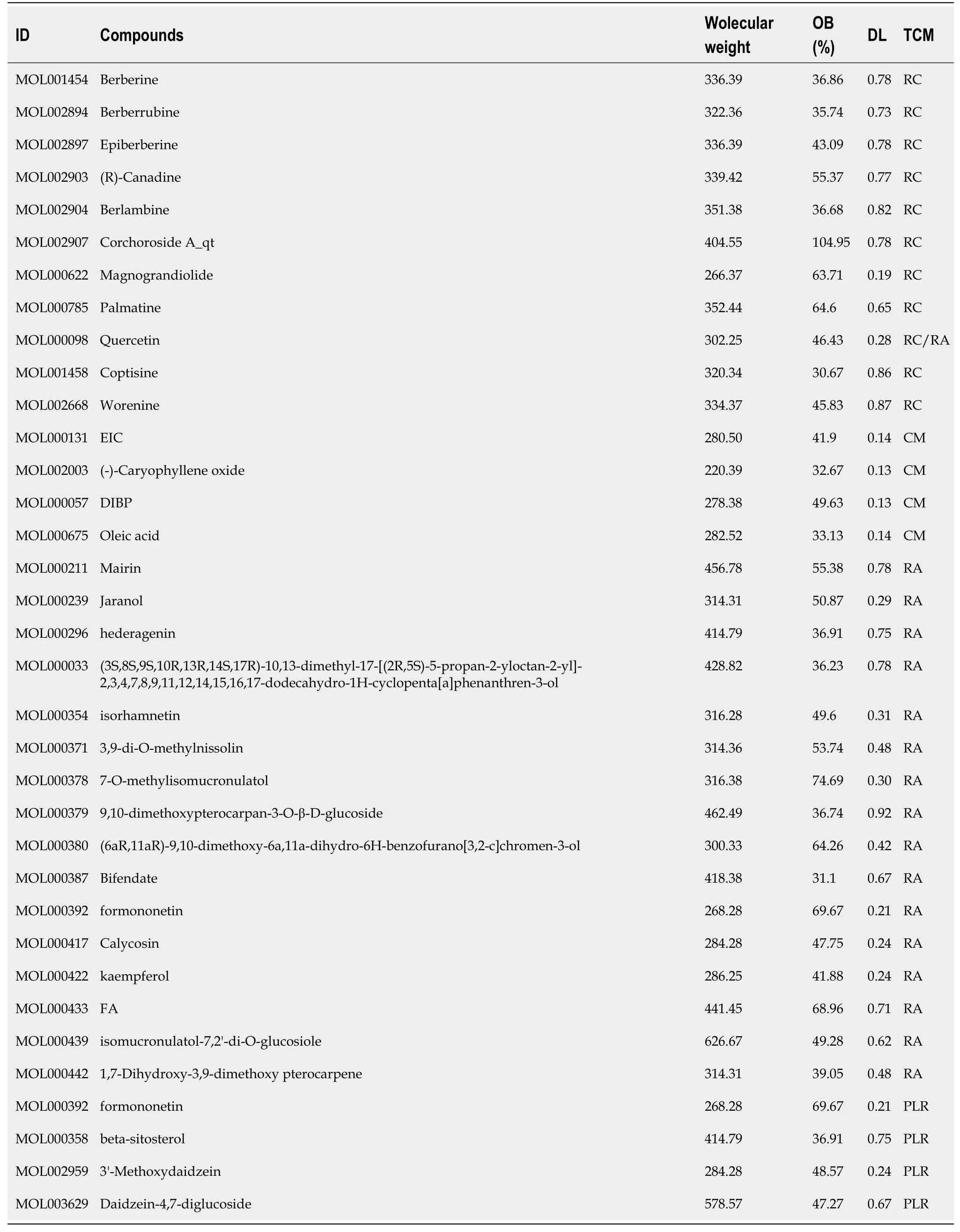
Table 1 Thirty-four active components with therapeutic effect on diabetic cardiomyopathy in Jiawei Jiaotai pill
Potential targets of Jiawei Jiaotai Pill in the treatment of DCM
Using GeneCards,6031 DCM target genes were identified.Taking the intersection of the target genes of the active components inJiawei Jiaotai Pill,100 common targets were obtained,which are the potential targets ofJiawei Jiaotai Pillin the treatment of DCM-(Figure 1).
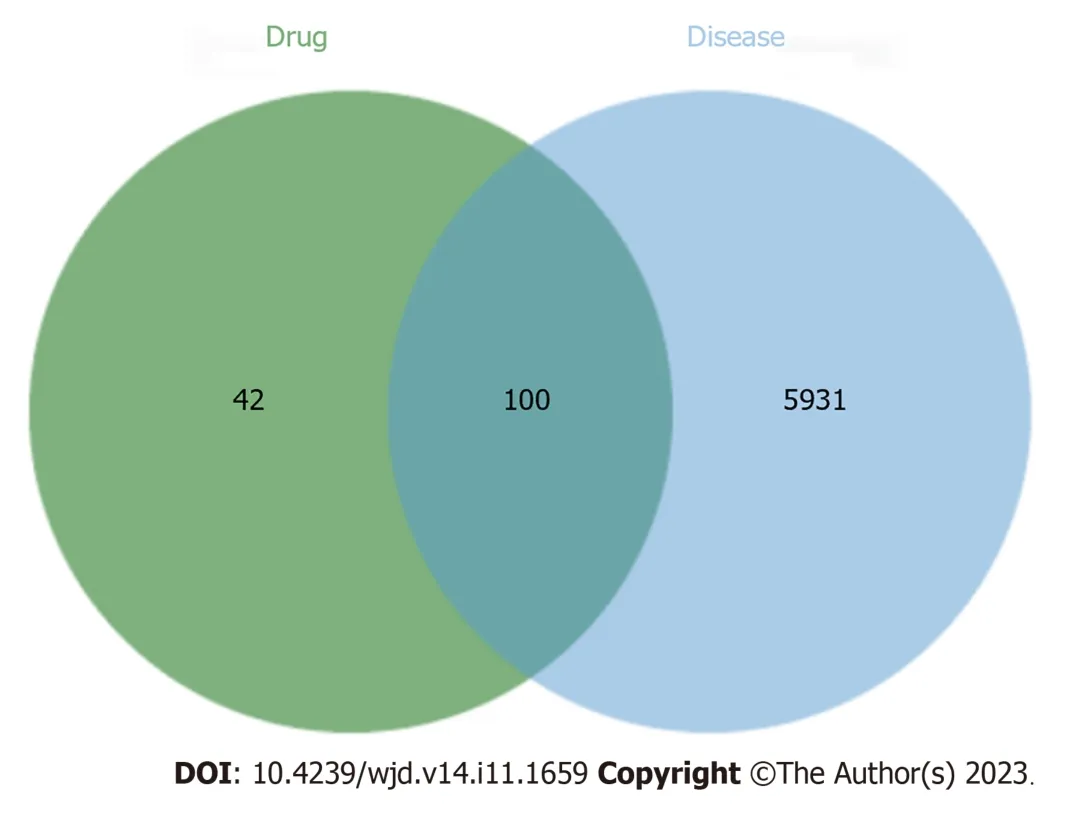
Figure 1 Venn diagram of the common target of Jiawei Jiaotai pill and diabetic cardiomyopathy. Drug: Jiawei Jiaotai pill;Disease: Diabetic cardiomyopathy.
Construction and analysis of the PPI network
One hundred potential targets were imported into the STRING platform to construct the PPI network.The PPI network and associated data files were analyzed and imported into the Cytoscape software 3.9.1 for further analysis and display,as shown in Figure 2.There were only 87 target genes as nodes and 287 as edges in the network diagram.Combined with the topological parameter analysis,the average value of “Degree” of all targets is 6.92,and there were 33 targets that exceeded the average “Degree” value for the first time (Figure 3A).The average value of “Closeness” of all targets was 30.02,and 30 targets exceeded the average “Closeness” value in the second screening (Figure 3B).The average value of “Betweenness” of all targets was 146.39,and there were 18 targets that exceeded the average “Betweenness” value in the third screening (Figure 3C).The interaction of these core targets may be key to the effect ofJiawei Jiaotai Pillon DCM.The top five key target genes were tumor necrosis factor (TNF),interleukin-6 (IL-6),cellular tumor antigen p53 (TP53),epidermal growth factor receptor (EGFR),and insulin (INS).
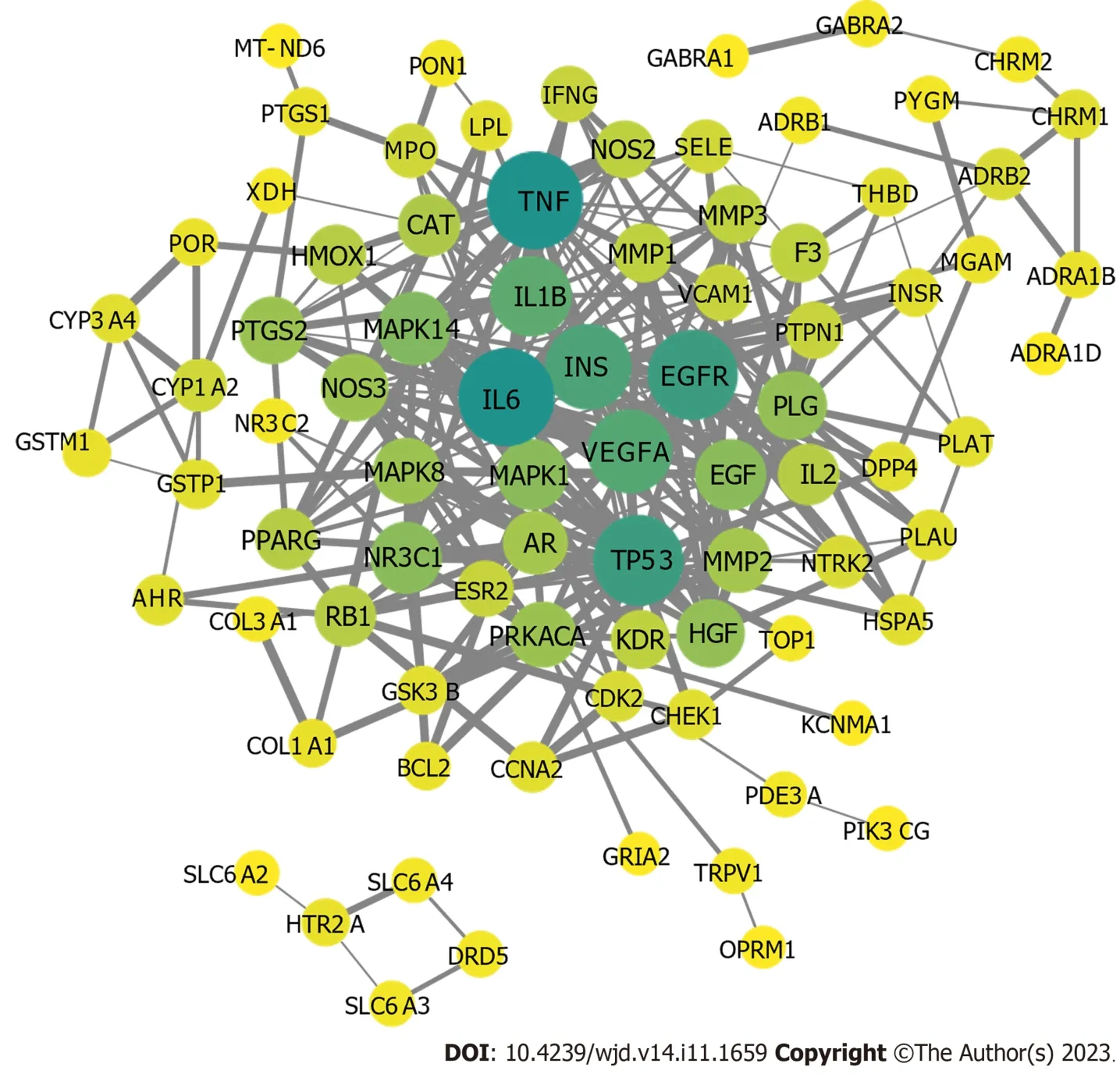
Figure 2 Protein-protein interaction network diagram of Jiawei Jiaotai pill in the treatment of diabetic cardiomyopathy.
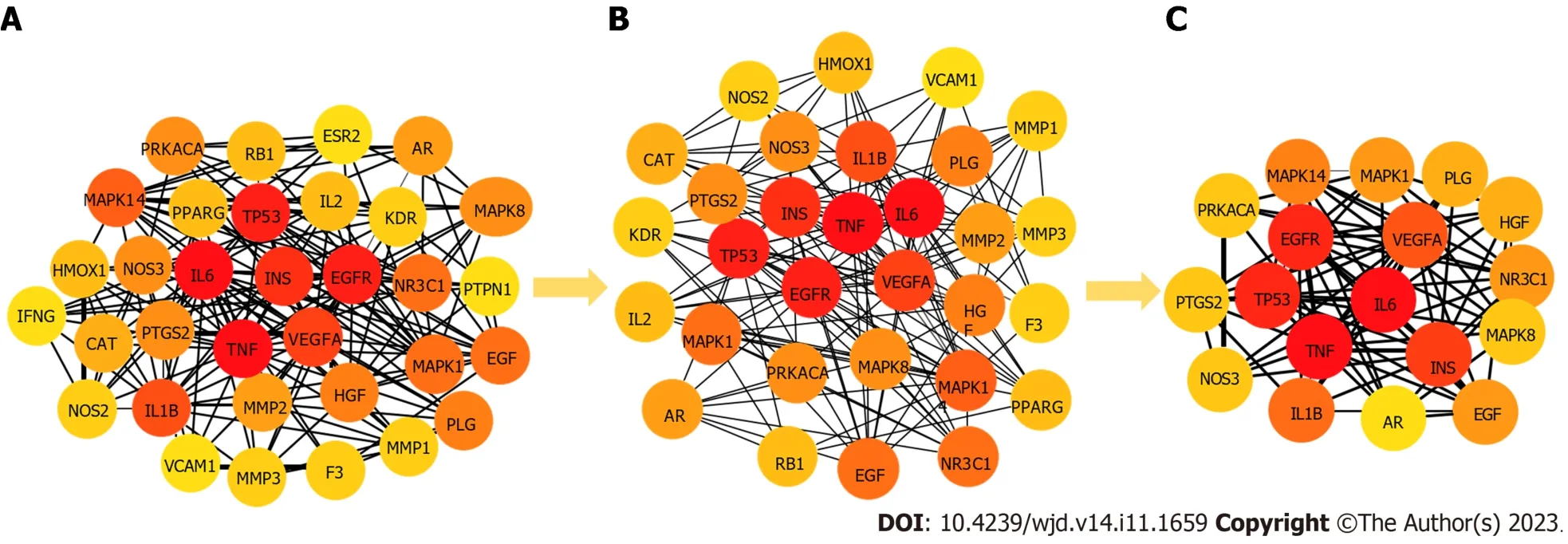
Figure 3 Topology calculation process diagram of key targets. A: In the initial screening,33 targets were found to exceed the average degree of freedom of all other targets;B: In the second screening,30 targets were found that exceeded the average closeness of all targets;C: In the third screening,18 targets were found that exceeded the average betweenness of all targets.
Construction of drug-active ingredient-target network diagram
To better illustrate the relationship between drugs,related compounds,and targets,TCM and its components and corresponding targets were used to construct a TCM compound target network map using Cytoscape,including 11 components of RC,four components of CM,17 components of RA,and four components of PLR,corresponding to 100 targets (Figure 4).The Cytoscape network analysis revealed 139 nodes and 502 edges.The average “Degree” value of all nodes was 7.22,the average “Closeness” value of all targets was 53.58,and the average “Betweenness” value of all targets was 226.75.The degree,closeness,and betweenness of quercetin,formononetin,kaempferol,7-O-methylisomucronulatol,and isorhamnetin were higher than the average of all node topological parameters,indicating that these five compounds were the main chemical components ofJiawei Jiaotai Pillin the treatment of DCM.Quercetin is also a common component of several TCMs (Table 2).
GO biological function enrichment analysis
The GO enrichment analysis revealed 324 biological processes.It mainly involved positive regulation of the mitogenactivated protein kinase (MAPK) cascade,response to xenobiotic stimuli,response to hypoxia,positive regulation of gene expression,positive regulation of cell proliferation,negative regulation of apoptotic processes,and other biological processes.There were 59 cell components,and analysis of the cell components suggested that they were involved in the caveola,plasma membrane,membrane raft,cell surface,and other tissue structures.The results showed that these mainly included protease binding,RNA polymerase II transcription factor activity,ligand-activated sequence-specific DNA binding,protein domain-specific binding,and other molecular functions (Figure 5).
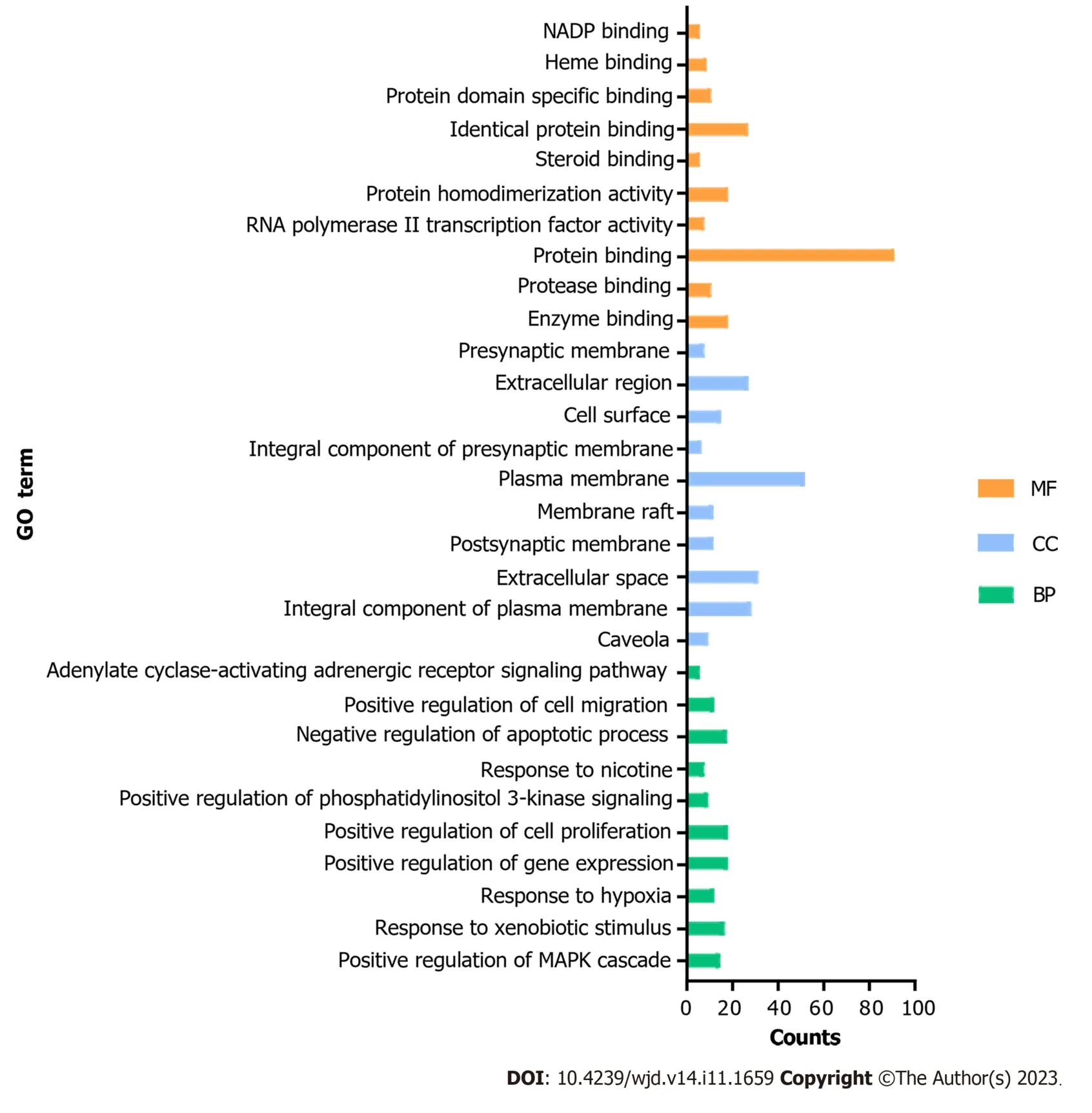
Figure 5 GO pathway bar chart. MF: Molecular function;CC: Cellular component;BP: Biological process;NADP: Nicotinamide adenine dinucleotide phosphate;MAPK: Mitogen-activated protein kinases.
KEGG pathway analysis
A total of 131 pathways were identified through KEGG pathway enrichment analysis (P< 0.05),and a bar chart of the first 20 pathways is shown in Figure 6.These pathways were mainly enriched in the AGE-RAGE signaling pathway in diabetic complications,fluid shear stress,atherosclerosis signaling pathway,DCM signaling pathway,PI3K-Akt signaling pathway,cGMP-PKG signaling pathway,IL-17 signaling pathway,and TNF signaling pathway.
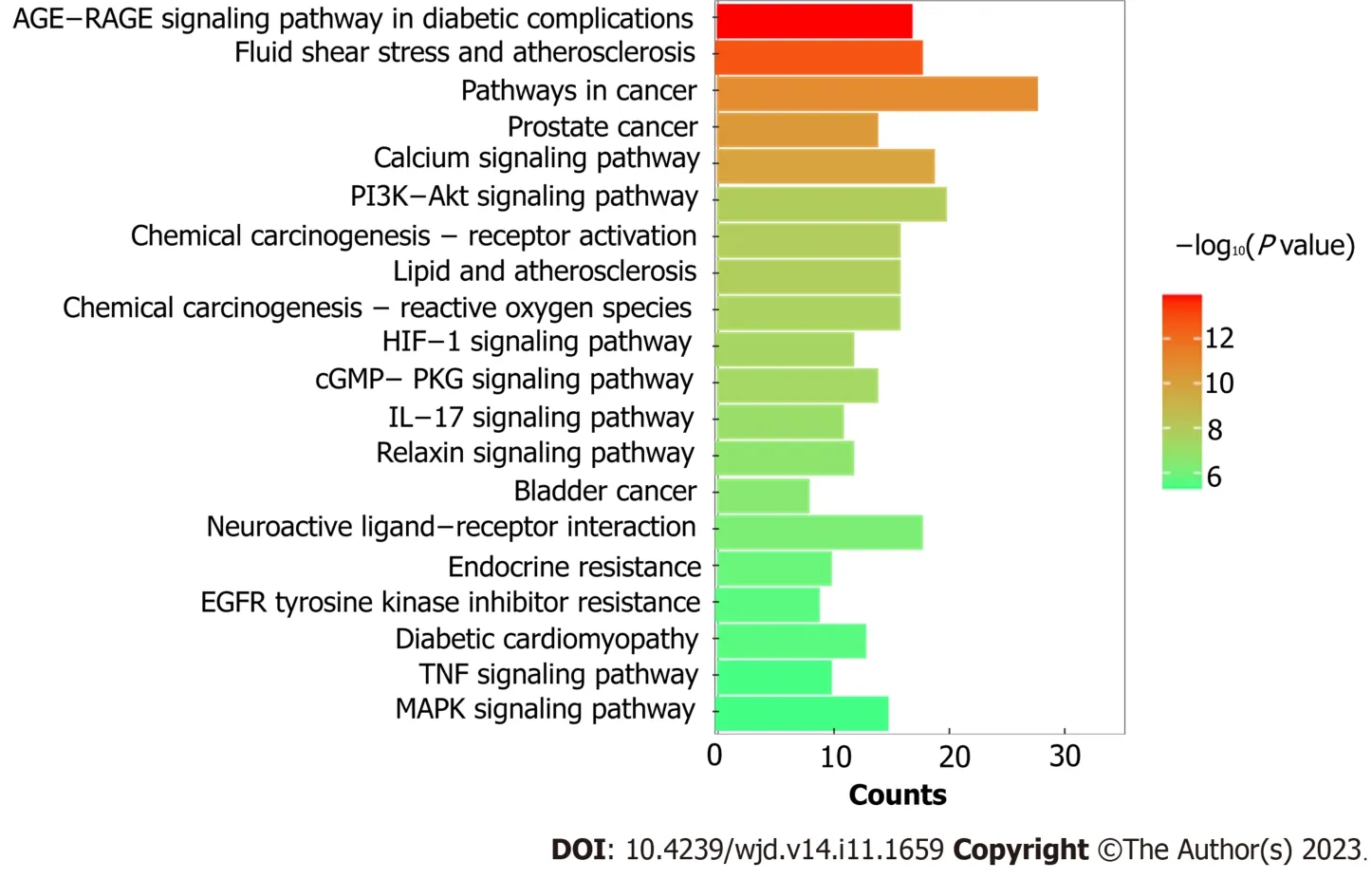
Figure 6 Kyoto Encyclopedia of Genes and Genomes enrichment analysis bar chart. HIF: Hypoxia-inducible factor;IL: Interleukin;EGFR: Epidermal growth factor receptor;TNF: Tumor necrosis factor;MAPK: Mitogen-activated protein kinases.
Molecular docking of active components and core targets
Molecular docking is an important tool in molecular simulations.The principle is to use spatial and energy matching between molecules to complete the recognition between two or more molecular structures.Taking the small chemical molecules and receptor proteins used in this study as examples,molecular docking can be used to predict their binding modes and estimate the strength of their binding ability,that is,the binding energy,also known as affinity.It is generally believed that the smaller the binding energy between the ligand and receptor,the more stable the molecular conformation of the ligand and receptor.From the PPI network diagram and TCM drug-core target network diagram,five core target proteins (TNF,IL-6,TP53,EGFR,and INS) and five core drugs (quercetin,formononetin,kaempferol,7-O-methylisomucronulatol,and isorhamnetin) were selected for binding energy prediction.The molecular docking results are presented in Table 3.The results showed that TNF,IL-6,TP53,EGFR,and INS had good binding abilities to quercetin,formononetin,kaempferol,7-O-methylisomucronulatol,and isorhamnetin.PyMOL software was used to visualize the partial docking results (Figure 7).
DlSCUSSlON
TheJiaotai pillis a TCM originally used by ancient practitioners to treat insomnia.Through ongoing research and development of secondary prescriptions in clinical practice,along with the application of the theory of treating different diseases with the same drugs and the use of yin and yang,the scope of prescription has expanded from insomnia and palpitations to include conditions such as depression and diabetes[5,6].Jiawei Jiaotai Pillcontains RA and PLR based on RC and CM.Astragalus polysaccharides found in RA partially improved myocardial glucose and lipid metabolismdisorders in diabetic hamsters and have a protective effect on the myocardium[13].Furthermore,PLR has good antiinflammatory properties and maintains cardiovascular and cerebrovascular functions[14].Although Jiawei Jiaotai pills are widely used in the treatment of diabetes and DCM in clinical practice,the pharmacological mechanism ofJiawei Jiaotai Pillremains unclear.Therefore,the application of theJiawei Jiaotai Pillin treating DCM is clearer based on network pharmacology.The active ingredients and mechanism of action,and the systematic interpretation of the pathway at the molecular biology level provide a pharmacological basis for the clinical application ofJiawei Jiaotai Pillin treating DCM,thereby improving its curative effect.
After screening the active components ofJiawei Jiaotai Pill,the results showed that quercetin,formononetin,kaempferol,7-O-methylisomucronulatol,and isorhamnetin had greater therapeutic effects,which may be the key active components in the treatment of DCM.In addition to oxidative stress,inflammation,myocardial cell death pathways,and neurohumoral mechanisms,the current understanding of the basic mechanisms of DCM in clinical research includes abnormalities in cardiac metabolism and physiological and pathophysiological signals such as abnormal changes in myocardial cells,myocardial insulin resistance,mitochondrial dysfunction,and abnormal oxidative stress[15].Quercetin,a flavonoid,exerts antioxidant effects by inhibiting oxidative damage to low-density lipoproteins,chelating metal ions,and directly scavenging reactive oxygen free radicals.It may also exert anti-inflammatory effects by regulating the production of inflammatory factors and inhibiting the nuclear factor-κB (NF-κB) and MAPK pathways.It also exerts hypoglycemic and lipid-lowering effects[16,17].Formononetin is a polyphenolic compound that regulates lipid metabolism by activating the AMPK and PPARγ pathways[18,19].Oza and Kulkarni[20] also found that 20 and 40 mg/kg formononetin could effectively improve blood lipid and glucose levels in diabetic rats by increasing the expression of human silent information regulator 1 in the pancreatic tissue.Kaempferol is a flavonol compound with anti-apoptotic,anti-inflammatory,and antioxidant properties[21].Studies have shown that kaempferol significantly inhibits the expression of inflammatory cytokines and the production of reactive oxygen species induced by high glucose,resulting in reduced fibrosis and apoptosis in vitro.Concurrently,it mediates DCM protection by inhibiting NF-κB nuclear translocation and activating nuclear factor erythroid 2 p45-related factor-2[22].Isorhamnetin is a natural small-molecule flavonoid found in many plants.It has many biological functions,including anti-inflammatory,antiviral,anti-myocardial,hypoxia-ischemia,and lipid-lowering properties[23].Isorhamnetin reduces myocardial injury by regulating the expression of autophagy and apoptosis pathway proteins in H9c2 cardiomyocytes.It also reduces the production of inflammatory mediators and decreases oxidative stress in diabetic rats by regulating NF-κB signaling activity[24,25].
The PPI and core target network diagrams revealed that the treatment of DCM withJiawei Jiaotai Pillmainly involves genes such asTNF,IL6,TP53,EGFR,andINS.TNF-α is a major cytokine associated with obesity.Wuet al[26] reported that TNF-α can promote the regulation of glucose homeostasis by upregulating plasma TNF-α levels.TNF-α may play an active role in reducing INS resistance in diabetic mice through a TNF-α receptor 1-independent manner.IL-6 is a proinflammatory cytokine that is frequently involved in diabetes-related inflammatory responses and is currently considered an important biomarkers for the risk of developing diabetes[27].IL-6 induces the expression of SOCS-3,a potential inhibitor of INS signal transduction,by controlling differentiation,migration,proliferation,and apoptosis,and impairs the phosphorylation of INS receptors and insulin receptor substrate-1,leading to insulin resistance[28].TP53 mainly acts as a tumor suppressor,controlling numerous signaling pathways and preventing malignant transformation of cells[29].Chenet al[30] suggested that pathological activation of the TP53 signaling pathway can induce myocardial fibrosis,apoptosis,heart failure,and premature death.The EGFR is a receptor tyrosine kinase that is widely expressed in various tissues,including the heart.Studies have shown that EGFR tyrosine kinase (EGFRtk) activity and endoplasmic reticulum (ER) stress increase in type 2 diabetic mice,leading to vascular dysfunction.Inhibition of EGFRtk and ER stress reduces apoptosis and inflammation and exerts cardioprotective effects.Therefore,targeting EGFRtk and ER stress may prevent myocardial infarction in patients with type 2 diabetes[31].Metabolic disorders caused by INS resistance or a lack of INS signaling are closely related to the pathogenesis of DCM.An imbalance in INS expression can impair glucose oxidation,resulting in the diversion of glucose to other metabolic pathways with deleterious effects on myocardial cell function[32].
Target GO analysis results showed thatJiawei Jiaotai Pillis mainly involved in the positive regulation of the MAPK cascade,response to xenobiotic stimulus,response to hypoxia,positive regulation of gene expression,positive regulation of cell proliferation,negative regulation of apoptotic processes,and other biological processes through the caveola,plasma membrane,membrane raft,cell surface,and other organizational structures.
Among the 20 KEGG enrichment pathways of related targets,the main pathways enriched were the AGE-RAGE signaling pathway in diabetic complications,the DCM signaling pathway,the PI3K-Akt signaling pathway,the IL-17 signaling pathway,and the MAPK signaling pathway.Targeting the AGE-RAGE pathway is a potential therapeutic strategy to improve DCM[33].Studies have shown that the accumulation of AGEs and activation of RAGE can induce continuous oxidative stress in vascular tissues,which may reduce the likelihood of diabetic macrovascular complications by inhibiting the AGE-RAGE pathway and subsequent oxidative stress[34].The PI3K/AKT signaling pathway is essential for metabolic homeostasis.The PI3K family is involved in the regulation of various physiological processes,including cell growth,survival,differentiation,autophagy,chemotaxis,and metabolism[35].AKT is downstream of PI3K in the INS signaling pathway and promotes a variety of cellular processes by targeting a large number of regulatory proteins that control glucose and lipid metabolism.Many studies have indicated that activation of the PI3K/Akt pathway may be the key mechanism for protection against DCM[36,37].IL-17 is a pro-inflammatory cytokine synthesized by T helper cells,macrophages,dendritic cells,and natural killer cells.It promotes the expression of inducible nitric oxide synthase and induces cardiomyocyte apoptosis.Simultaneously,it activates matrix metalloproteinases,resulting in increased synthesis of the extracellular matrix in cardiomyocytes,leading to myocardial fibrosis and playing an important role in DCM.IL-17 Levels increase with the deterioration of cardiac function[38,39].The MAPK pathway is activated by p38MAPK under high glucose conditions,and dysfunction occurs.Qianet al[40] found that inhibiting the expression of p38MAPK can rescue the MAPK pathway,thereby significantly ameliorating myocardial injury and dysfunction in diabetic mice.In summary,this study applied network pharmacology methods and molecular docking techniques to preliminarily explore the complex mechanism of multi-component,multi-target,and multi-pathways in the treatment of DCM through the active components inJiawei Jiaotai Pill.
This study still has certain limitations.This study is only a preliminary theoretical determination of the molecular mechanism of the treatment of DCM withJiawei Jiaotai Pilland is a predictive study.Future specific experiments are needed to further validate the results of this study.
CONCLUSlON
The active components inJiawei Jiaotai Pillinclude quercetin,formononetin,kaempferol,7-O-methylisomucronulatol,and isorhamnetin,which act synergistically on target proteins such as TNF,IL-6,TP53,EGFR,and INS.It regulates the AGERAGE signaling pathway in diabetic complications,DCM pathway,PI3K-Akt signaling pathway,IL-17 signaling pathway,and MAPK signaling pathway to reduce the body's oxidative stress level,reduce myocardial cell apoptosis and fibrosis,and maintain metabolic homeostasis.The active components ofJiawei Jiaotai Pillmainly play a role in inhibiting inflammatory response,antioxidant response,anti-apoptosis,improving INS resistance,and stimulating INS secretion for the treatment of DCM.
ARTlCLE HlGHLlGHTS
Research background
Diabetic cardiomyopathy (DCM) is a type of cardiomyopathy independent of hypertension,coronary artery disease,and vascular complications.Traditional Chinese medicine (TCM) has unique advantages for treating this disease.In the current study,Jiawei Jiaotai Pillwas widely used for the treatment of diabetes and its complications.Jiawei Jiaotai Pillhas increased the use of Radix Astragali and Puerariae Lobatae Radix.It was also found that these two drugs had protective effects on the heart.
Research motivation
To improve the efficacy in DCM patients and further clarify the pharmacological basis of theJiawei Jiaotai Pill,it is necessary to study the molecular mechanism of theJiawei Jiaotai Pillin the treatment of DCM.
Research objectives
Based on the network pharmacology method and molecular docking technology,this study analyzed the effective active ingredients and important gene targets inJiawei Jiaotai Pilland provided a reference for clinical treatment.
Research methods
The targets of the four TCMs inJiawei Jiaotai Pillfor DCM were identified using relevant databases.The core targets and compounds were identified using a protein-protein interaction network and a drug-active ingredient-target network.Gene ontology and Kyoto Encyclopedia of Genes and Genomes analyses were used to determine the related pathways of biological processes,and molecular docking was performed for verification.
Research results
The main components ofJiawei Jiaotai Pillused in the treatment of DCM are quercetin,formononetin,kaempferol,7-Omethylisomucronulatol,and isorhamnetin.These components can act synergistically on disease-related target proteins such as tumor necrosis factor,interleukin-6 (IL-6),cellular tumor antigen p53,epidermal growth factor receptor,and insulin,and play therapeutic roles through the AGE-RAGE signaling pathway,PI3K/Akt,IL-17,and mitogen-activated protein kinase pathways.However,as predicted,the specific mechanism ofJiawei Jiaotai Pillrequires further verification.
Research conclusions
The active ingredients ofJiawei Jiaotai Pillhave a complex mechanism involving multiple components,targets,and pathways in the treatment of DCM,which may protect myocardial function by reducing the level of oxidative stress,reducing cardiomyocyte apoptosis and fibrosis,and maintaining metabolic homeostasis.
Research perspectives
Based on network pharmacology and molecular docking technology,the related mechanism ofJiawei Jiaotai Pillin the treatment of DCM was speculated,providing a reference for future experimental verification.
FOOTNOTES
Author contributions:Wang YJ and Wang YL contributed to the literature search;Jiang XF performed the data acquisition and statistical analysis;Li JE contributed to the manuscript preparation and editing;All authors have approved the final manual.
Supported byNatural Science Basic Research Plan in the Shaanxi Province of China,No.2021JM-549,The Plan Project of Shaanxi Provincial Administration of Traditional Chinese Medicine,No.2021-ZZ-JC011;and The Second Youth Science and Technology Talents Project of Shaanxi Provincial Administration of Traditional Chinese Medicine,No.2023-ZQNY-017.
lnstitutional review board statement:The data used in this study are all public data from public databases,and do not involve human or animals data,so there is no need for ethical review.
Conflict-of-interest statement:The authors declare no conflict of interest.
Data sharing statement:The data used for this study can be obtained from the corresponding authors at lizhuan-1980@126.com.
ARRlVE guidelines statement:The authors have read the ARRIVE guidelines,and the manuscript was prepared and revised according to the ARRIVE guidelines.
Open-Access:This article is an open-access article that was selected by an in-house editor and fully peer-reviewed by external reviewers.It is distributed in accordance with the Creative Commons Attribution NonCommercial (CC BY-NC 4.0) license,which permits others to distribute,remix,adapt,build upon this work non-commercially,and license their derivative works on different terms,provided the original work is properly cited and the use is non-commercial.See: https://creativecommons.org/Licenses/by-nc/4.0/
Country/Territory of origin:China
ORClD number:Yu-Juan Wang 0009-0000-6175-0014;Yan-Li Wang 0009-0007-3762-4721;Xiao-Fan Jiang 0009-0002-7582-1965;Juan-E Li 0009-0004-3322-8463.
S-Editor:Fan JR
L-Editor:A
P-Editor:Chen YX
杂志排行
World Journal of Diabetes的其它文章
- Cellular and molecular overview of gestational diabetes mellitus: ls it predictable and preventable?
- Exploring the targets and molecular mechanism of glycyrrhetinic acid against diabetic nephropathy based on network pharmacology and molecular docking
- Vascular endothelial growth factor B improves impaired glucose tolerance through insulin-mediated inhibition of glucagon secretion
- Reduced risk of dementia in patients with type 2 diabetes mellitus using Chinese herbal medicine: A nested case-control study
- Molecular mechanisms of noncoding RNA and epigenetic regulation in obesity with consequent diabetes mellitus development
- Mechanisms of action of natural products on type 2 diabetes
